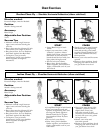
31
Chest Exercises
Standing Chest Fly — Shoulder Horizontal Adduction (elbow stabilization)
START FINISH
START
• Grasp the handles so the
cables lie close to the front
of your forearms and palms
facing forward.
• Stand with one foot forward
and one foot back for added
stability.
• Stabilize the elbows so they
are slightly bent and slightly
behind or equal to the
shoulders.
• Slowly move the arms forward
and inward, bringing the
handles together in front of
you.
• Slowly return to the Start
position, keeping tension
on the chest throughout the
motion.
FINISH
Muscles worked:
Pectoralis Major; Deltoids. Also ankles,
knees, hips and core in stabilization.
Position:
Standing—facing outward. Seat removed.
Accessory:
Long Hand Grips
Adjustable Arm Position:
4, 5 or 6
Success Tips
• Stabilize body from your feet all the
way up through your trunk.
• Maintain a 90° angle between upper
arms and torso throughout the
motion.
• Keep chest muscles tight, limit and
control your range of motion.
• Keep knees slightly bent, feet flat on
the floor and in a staggered step for
stability.
• Keep shoulder blades pinched, chest
lifted and a slight curve in the lower
back.
Standing Incline Chest Fly — Shoulder Horizontal Adduction (elbow stabilization)
START FINISH
START
• Grasp the handles so the
cables lie close to the front of
your forearms, and palms face
forward.
• Stand with one foot forward
and one foot back for added
stability.
• Stabilize the elbows so they
are slightly bent and slightly
behind or even with the
shoulders.
• Slowly move the arms slightly
upward and inward, bringing
the handles together in front
of you at about neck/chin
height.
• Slowly return to the Start
position, keeping tension
on the chest throughout the
motion.
FINISH
Muscles worked:
Pectoralis Major; Deltoids. Also ankles,
knees, hips and core in stabilization.
Position:
Standing—facing outward. Seat re-
moved.
Accessory:
Long Hand Grips
Adjustable Arm Position:
4, 5 or 6
Success Tips
• Stabilize body from your feet all the
way up through your trunk.
• Keep chest muscles tight, limit and
control your range of motion.
• Keep knees slightly bent, feet flat on
the floor and in a staggered step for
stability.
• Keep shoulder blades pinched, chest
lifted and a slight curve in the lower
back.


















